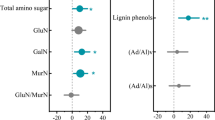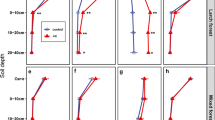Abstract
Nitrogen (N) fertilization, as a grassland management strategy, has been widely used to improve forage quality and increase the productivity of grasslands degraded by overstocking. It is widely accepted that N addition will alter ecosystem structure and function, and that these effects may be altered by natural disturbances, such as fire. We examined the effects of annual burning and N fertilization (17.5 g N m−2 year−1, at a surplus rate in order to simulate agriculture treatment) on foliar chemistry and stoichiometric ratios of eight dominant species (Leymus chinensis, Stipa grandis, Cleistogenes squarrosa, Potentilla bifurca, Thalictrum squarrosum, Artemisia frigida, Kochia prostrata and Caragana microphylla) in a temperate steppe in northern China. After 3 years of treatments, annual burning significantly increased soil extractable phosphorus (P) concentration but showed no effects on soil inorganic N concentration, whereas N fertilization caused a significant increase in inorganic N concentration but not of extractable P. Species differed substantially with respect to all nutritional and stoichiometric variables. Both annual burning and N fertilization caused significant increases in foliar N and P concentrations and thus decreases in carbon (C):N and C:P ratios. While annual burning showed no effects on N:P ratios, N fertilization produced higher N:P ratios. However, species responded idiosyncratically to both fire and N fertilization in terms of foliar N concentration, C:N and N:P ratio. In addition, there was no interaction between fire and N fertilization that affected all variables. This study suggests that both annual burning and N fertilization have direct impacts on plant elemental composition and that fire- and N addition-induced changes of community composition may have important consequences for plant-mediated biogeochemical cycling pathways in temperate steppe ecosystem.



Similar content being viewed by others
References
Ågren GI (2008) Stoichiometry and nutrition of plant growth in natural communities. Annu Rev Ecol Evol S 39:153–170
Anderson TM, Ritchie ME, Mayemba E, Eby S, Grace JB, McNaughton SJ (2007) Forage nutritive quality in the serengeti ecosystem: the roles of fire and herbivory. Am Nat 170:343–357
Bai YF, Wu JG, Clark CM, Naeem S, Pan QM, Huang JH, Zhang LX, Han XG (2010) Tradeoffs and thresholds in the effects of nitrogen addition on biodiversity and ecosystem functioning: evidence from Inner Mongolia grasslands. Glob Change Biol 16:358–372
Bennett LT, Judd TS, Adams MA (2002) Growth and nutrient content of perennial grasslands following burning in semi-arid, sub-tropical Australia. Plant Ecol 164:185–199
Blair JM (1997) Fire, N availability, and plant response in grasslands: a test of the transient maxima hypothesis. Ecology 78:2359–2368
Briggs JM, Knapp AK, Blair JM, Heisler JL, Hoch GA, Lett MS, McCarron JK (2005) An ecosystem in transition. Causes and consequences of the conversion of mesic grassland to shrubland. Bioscience 55:243–254
Britton AJ, Helliwell RC, Fisher JM, Gibbs S (2008) Interactive effects of nitrogen deposition and fire on plant and soil chemistry in an alpine heathland. Environ Pollut 156:409–416
Cech PG, Kuster T, Edwards PJ, Venterink HO (2008) Effects of herbivory, fire and N2-fixation on nutrient limitation in a humid Afirican Savanna. Ecosystems 11:991–1004
Clark CM, Cleland EE, Collins SL, Fargione JE, Gough L, Gross KL, Pennings SC, Suding KN, Grace JB (2007) Environmental and plant community determinants of species loss following nitrogen enrichment. Ecol Lett 10:596–607
Contant RT, Paustian K, Elliott ET (2001) Grassland management and conversion into grassland: effects on soil carbon. Ecol Appl 11:343–355
Craine JM, Morrow C, Stock WD (2008) Nutrient concentration ratios and co-limitation in South African grasslands. New Phytol 179:829–836
Dyer AR, Rice KJ (1997) Intraspecific and diffuse competition: the response of Nassella pulchra in a California grassland. Ecol Appl 7:484–492
Elser JJ, Bracken MES, Cleland EE, Gruner DS, Harpole WS, Hillebrand H, Ngai JT, Seabloom EW, Shurin JB, Smith JE (2007) Global analysis of nitrogen and phosphorus limitation of primary producers in freshwater, marine and terrestrial ecosystems. Ecol Lett 10:1135–1142
Esmeijer-Liu A, Aerts R, Kurschner W, Bobbink R, Lotter A, Verhoeven J (2009) Nitrogen enrichment lowers Betula pendula green and yellow leaf stoichiometry irrespective of effects of elevated carbon dioxide. Plant Soil 316:311–322
Güsewell S, Gessner MO (2009) N:P ratios influence litter decomposition and colonization by fungi and bacteria in microcosms. Funct Ecol 23:211–219
Granath G, Strengbom J, Breeuwer A, Heijmans M, Berendse F, Rydin H (2009) Photosynthetic performance in Sphagnum transplanted along a latitudinal nitrogen deposition gradient. Oecologia 159:705–715
Hall SR, Shurin JB, Diehl S, Nisbet RM (2007) Food quality, nutrient limitation of secondary production, and the strength of trophic cascades. Oikos 116:1128–1143
He JS, Fang JY, Wang ZH, Guo DL, Flynn DFB, Geng Z (2006) Stoichiometry and large-scale patterns of leaf carbon and nitrogen in the grassland biomes of China. Oecologia 149:115–122
He JS, Wang L, Flynn DFB, Wang XP, Ma WH, Fang JY (2008) Leaf nitrogen: phosphorus stoichiometry across Chinese grassland biomes. Oecologia 155:301–310
Henry HAL, Chiariello NR, Vitousek PM, Mooney HA, Field CB (2006) Interactive effects of fire, elevated carbon dioxide, nitrogen deposition, and precipitation on a California annual grassland. Ecosystems 9:1066–1075
Huang JJ, Boerner REJ (2007) Effects of fire alone or combined with thinning on tissue nutrient concentrations and nutrient resorption in Desmodium nudiflorum. Oecologia 153:233–243
Jiang GM, Han XG, Wu JG (2006) Restoration and management of the Inner Mongolia grassland require a sustainable stragegy. AMBIO 35:269–270
Knops JMH, Naeem S, Reich PB (2007) The impact of elevated CO2, increased nitrogen availability and biodiversity on plant tissue quality and decomposition. Glob Change Biol 13:1960–1971
Kozovits AR, Bustamante MMC, Garofalo CR, Bucci S, Franco AC, Goldstein G, Meinzer FC (2007) Nutrient resorption and patterns of litter production and decomposition in a neotropical savanna. Funct Ecol 21:1034–1043
LeBauer DS, Treseder KK (2008) Nitrogen limitation of net primary productivity in terrestrial ecosystems is globally distributed. Ecology 89:371–379
Liu WX, Xu WH, Han Y, Wang CH, Wan SQ (2007) Responses of microbial biomass and respiration of soil to topography, burning, and nitrogen fertilization in a temperate steppe. Biol Fert Soils 44:259–268
McNaughton SJ, Stronach NRH, Georgiadis NJ (1998) Combustion in natural fires and global emissions budgets. Ecol Appl 8:464–468
Menge DNL, Field CB (2007) Simulated global changes alter phosphorus demand in annual grassland. Glob Change Biol 13:2582–2591
Niklas KJ, Owens T, Reich PB, Cobb ED (2005) Nitrogen/phosphorus leaf stoichiometry and the scaling of plant growth. Ecol Lett 8:636–642
Niklaus PA, Leadley PW, Stocklin J, Korner C (1998) Nutrient relations in calcareous grassland under elevated CO2. Oecologia 116:67–75
Novotny AM, Schade JD, Hobbie SE, Kay AD, Kyle M, Reich PB, Elser JJ (2007) Stoichiometric response of nitrogen-fixing and non-fixing dicots to manipulations of CO2, nitrogen, and diversity. Oecologia 151:687–696
Ojima DS, Schimel DS, Parton WJ, Owensby CE (1994) Long- and short-term effects of fire on nitrogen cycling in tallgrass prairie. Biogeochemistry 24:67–84
Pan QM, Bai YF, Han XG, Yang J (2005) Effects of nitrogen additions on a Leymus chinensis population in typical steppe of Inner Mongolia. Acta Phytoecologica Sinica 29:311–317
Perring MP, Hedin LO, Levin SA, McGroddy M, de Mazancourt C (2008) Increased plant growth from nitrogen addition should conserve phosphorus in terrestrial ecosystems. Proc Natl Acad Sci USA 105:1971–1976
Rau BM, Blank RR, Chambers JC, Johnson DW (2007) Prescribed fire in a Great Basin sagebrush ecosystem: dynamics of soil extractable nitrogen and phosphorus. J Arid Environ 71:362–375
Reich PB, Peterson DW, Wedin DA, Wrage K (2001) Fire and vegetation effects on productivity and nitrogen cycling across a forest-grassland continuum. Ecology 82:1703–1719
Schimel DS, Kittel TGF, Knapp AK, Seastedt TR, Parton WJ, Brown VB (1991) Physiological interactions along resource gradients in a tallgrass prairie. Ecology 72:672–684
Turner CL, Blair JM, Schartz RJ, Neel JC (1997) Soil N and plant responses to fire, topography, and supplemental N in tallgrass prairie. Ecology 78:1832–1843
Van de Vijver C, Poot P, Prins HHT (1999) Causes of increased nutrient concentrations in post-fire regrowth in an East African savanna. Plant Soil 214:173–185
Vance CP, Uhde-Stone C, Allan DL (2003) Phosphorus acquisition and use: critical adaptations by plants for securing a nonrenewable resource. New Phytol 157:423–447
Veen GF, Blair JM, Smith MD, Collins SL (2008) Influence of grazing and fire frequency on small-scale plant community structure and resource variability in native tallgrass prairie. Oikos 117:859–866
Vitousek PM (1982) Nutrient cycling and nutrient use efficiency. Am Nat 119:553–572
Wan SQ, Hui DF, Luo YQ (2001) Fire effects on nitrogen pools and dynamics in terrestrial ecosystems: a meta-analysis. Ecol Appl 11:1349–1365
Xia JY, Wan SQ (2008) Global response patterns of terrestrial plant species to nitrogen addition. New Phytol 179:428–439
Xu WH, Wan SQ (2008) Water- and plant-mediated responses of soil respiration to topography, fire, and nitrogen fertilization in a semiarid grassland in northern China. Soil Biol Biochem 40:679–687
Zhou LS, Huang JH, Lu FM, Han XG (2009) Effects of prescribed burning and seasonal and interannual climate variation on nitrogen mineralization in a typical steppe in Inner Mongolia. Soil Biol Biochem 41:796–803
Acknowledgements
We gratefully acknowledge Deliang Kong, Weijun Wu, Qiang Li for field and laboratory assistance, Arianne Cease for language improvement and valuable comments on the earlier versions of this manuscript. We thank two anonymous reviewers and Harry Olde Venterink for their thoughtful comments, which helped in improving the manuscript. This research was supported by the State Key Basic Research Development Program of China (2007CB106801) and the National Natural Science Foundation of China (30830026, 30821062).
Author information
Authors and Affiliations
Corresponding author
Additional information
Responsible Editor: Harry Olde Venterink.
Qiang Cui and Xiao-Tao Lü contributed equally to this work.
Appendix 1
Appendix 1
The effects of fire and nitrogen fertilization (C, control; F, fire; N, nitrogen fertilization; F+N, both fire and N fertilization) on the foliar stoichiometric ratios of each species.

Rights and permissions
About this article
Cite this article
Cui, Q., Lü, XT., Wang, QB. et al. Nitrogen fertilization and fire act independently on foliar stoichiometry in a temperate steppe. Plant Soil 334, 209–219 (2010). https://doi.org/10.1007/s11104-010-0375-5
Received:
Accepted:
Published:
Issue Date:
DOI: https://doi.org/10.1007/s11104-010-0375-5




